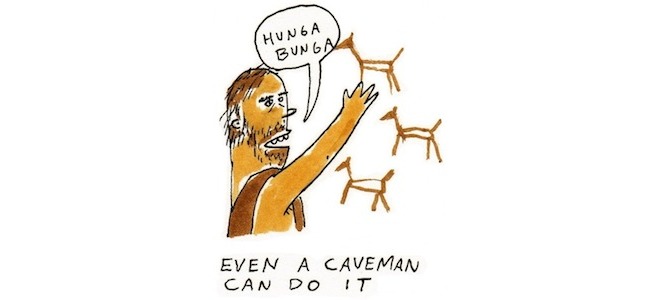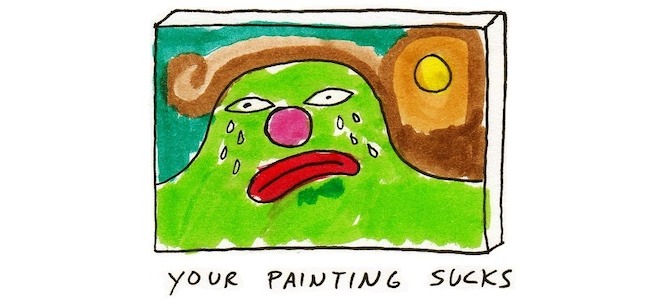Read that headline carefully. Note that I didn’t say everyone should start calling themselves artists and try to sell their paintings for thousands of dollars. I do, however, think the exercise of making a painting is a good one for all human beings.
Painting has been around almost as long as hunting and gathering, and there are very few activities that are so innate to our species. Resolving a painting is a puzzle, a maze, a riddle, a quest, all that. It is a process requiring a billion decisions. Want to try a great game? Put down that electronic device and pick up a brush. Get in touch with your human part. Even Michael Jackson’s former pet chimp, Bubbles, is doing it. Elephants do it. It’s a genus thing.

Getting started, the gathering part
You are going to need some paint, some instruments to paint with, and an object to paint on. Got a $100 bucks? That should be enough to get you started.
First off, don’t use really crappy paint. It is not impossible, but it is significantly harder to make a good painting with student grade paint. Get a set with eight to ten colors. This will cost you 35-50 bucks. Here’s one.
(Note: I’m spreading the links around between Blick, Utrecht, Amazon, and Cheap Joes. All are good options, as is Mom and Pop’s down the street. Look for sales.)
Next, get some brushes. Brushes can be crazy expensive. You don’t need fancy sable brushes to get started, but you shouldn’t get kid stuff either. Get a decent synthetic set with a variety of shapes: 20 – 30 bucks. I like
long handles because they can also be used to kill vampires.
Get something to paint on. Canvas works. Do you have your own woodshop and like to make things ten times more complicated than they need to be? No, then don’t stretch your own canvas. There are some great options at the store. Get a few canvasses so you can make mistakes. One of my former instructors told me that you always make your best paintings on shitty canvasses, and I have found that to be true wisdom.
Rig up an easel. You can paint on a tabletop or on the floor, but I think it is really important to learn how to paint from a vertical position. If you have the option, hanging a canvas on the wall and working from there is preferable to working horizontally on a table. There are Easels that cost as much as a ‘04 Lexus ES300. You don’t need that one. Start out with a $20 tabletop easel. If you have more room and this pursuit is going to be lasting, get a real easel. Later on you can store it with the treadmill.
One more thing. You will also need a palette and a cup. Paper towels and newspaper may also be useful. For a palette I recommend a sturdy, disposable, plastic plate. Anything non-porous and solid will do. Glass, marble, old electronics, sealed cardboard, or even another painting will work as a palette. For a cup use something substantial enough in size and stable enough in shape to hold brushes. Old soup cans work. So do plastic beer cups. I have even sawed off the top of a Gatorade bottle and used that. This cup will hold dirty paint water. Choose a cup that you will never want to drink out of again. You don’t want to drink dirty paint water.
Getting started, the hunting part
Let’s paint. If you are painting on the counter with a tabletop easel, put some newspaper or something else down so you don’t ruin the counter, you idiot. Also, take off that expensive suit. Next, put the blank canvas on the easel, raise it to a comfortable height, and take in the intimidating blankness of it all.
Now what? Well you haven’t finished setting up yet. You are going to have to find a place to set some stuff down. Find a little side table, or a stool, if you aren’t already working from a table, and put it on the right or left side of the canvas, depending on your dominant hand. Now, go fill the cup 72% of the way with water and set it on your table. Also find some space for your palette and some tubes of paint. Take out those brushes and drop two of them, bristles first, into the water.
You are ready to paint.
A few things…
- Your painting is going to suck. Don’t worry about it.
- Don’t squirt tons of paint out on to your palette; a little goes a long way. You purchased the good stuff and you are going to thin it with water. At the same rate, don’t be afraid to waste paint. It’s not precious, and you have a job, right?
- These instructions are for acrylic paint. Oil paint is awesome, but it takes forever to dry and involves more complicated instructions. The fumes are also bad. Acrylics are a good place to start because they dry so quickly and the base comes out of the faucet.
- You can always paint over it. If you paint something horrible and embarrassing, or you just plain messed up, wait a few minutes and paint over it. It’s as easy as that.
- Keep the brushes wet. Do you know what happens when paint dries on brushes? Brushes go into trash. There are dry brush techniques, but when you are starting out, I suggest painting wet on dry, meaning you are putting wet paint onto a dry surface. You will get this moisture on the brush by putting the brush into water, maybe blotting it out a wee bit with a paper towel, and then putting brush into the paint. This is a variable. Here is where some of the advanced level thinking takes place. Go figure it out. Add some water to your brush and the paint moves better.
- Think about what color you want to make when you are mixing. Mixing paint is way cool, but have a plan in mind. Don’t squirt random colors next to each other and mush them together. That will only create a bunch of dirty, ugly colors. Colors won’t mix the way you expect them too. Try a little bit. Play around. Adding white often helps. Add some white to Ultramarine Blue and your mind will be blown. Avoid adding black to colors to make them darker. That’s bush league. Ivory black is made from charred animal bones. That’s just a cool fact. Mix the colors on the palette with your brush. Plan it out as you go. Use thinking.
- Your painting is going to suck. Don’t worry about it.
Now What?
What are you painting? How do you do it?
Most intro to painting classes start with painting a still life because it removes the question of what to paint. Many intro classes also start with only using black and white to simplify the decision making process. That to me sounds incredibly boring, but I once did it, and I probably learned from it. You can start that way or you can try skipping ahead. No one is watching. You can do whatever you want.
 How do you actually paint, as in techniques and stuff? Just do it. Experiment. There are techniques, of course, but the best technique is the one you invent. Do you know what happens in art school? There is a lot of big talk about the art you made and the art you are going to make and the historical context and words like “derivative” get thrown out there (everything is derivative), but when it comes to painting there is very little instruction. You pretty much go and figure it out. That’s what you do now. It helps to have taste. If you have an idea about what kind of painting you like, that is going to push you in the right direction. If you don’t have an idea about what you like, then you should probably go figure that out. Or just paint your shoes.
How do you actually paint, as in techniques and stuff? Just do it. Experiment. There are techniques, of course, but the best technique is the one you invent. Do you know what happens in art school? There is a lot of big talk about the art you made and the art you are going to make and the historical context and words like “derivative” get thrown out there (everything is derivative), but when it comes to painting there is very little instruction. You pretty much go and figure it out. That’s what you do now. It helps to have taste. If you have an idea about what kind of painting you like, that is going to push you in the right direction. If you don’t have an idea about what you like, then you should probably go figure that out. Or just paint your shoes.
This painting sucks
Of course your painting sucks. The vast majority of paintings suck. Even Picasso made lousy paintings. I went searching for a bad Picasso to illustrate my point and the article accompanying the painting I chose was about how some smart guy thought that this painting was Picasso’s best. That only goes to show that no one knows what they are talking about. I only like a small fraction of the paintings I see and you are only going to like a small fraction of the paintings you see, and they are probably going do be different paintings than the ones I liked, so everyone is wrong.
Why do it, then? Because it is good for you. It is a great exercise, and when is the last time you did something a caveman did? The only way you can go wrong is by being too self-important with the whole thing. I have seen CEOs of Fortune 500 companies painting beside adults with developmental disabilities, and guess who did the better painting? Not the rich guy. Don’t assume that because you are a brilliant UI Designer, it means that you are a great artist, and that your paintings are worth a fortune. Don’t worry about it. Only jerks try to sell art.
Clean your brushes with water when you are done.
Have fun!

Jamie
on 14 Dec 12Great post. I think I’ll paint something soon.
Henry K
on 14 Dec 12Louie CK would call this blog post White People Problems
M
on 14 Dec 12You may also want to try a one-evening instructor-led painting class … like Wine & Canvas. The wine is optional, but I feel it draws out the creativity in everyone.
Tyler
on 14 Dec 12I went to art school, with scholarships for painting, but I’m now a programmer. I think you missed a few things. First, most people paint as kids and get all of this when they are younger. The reason why people stop is because other things often interest them more. Like jobs that pay money, and so on. I can see coming back to all of this like many people do in retirement. But at the core of the concept, painting is the freedom of looking at the blank canvas and letting your creativity fly in whatever direction the brushes are taking you. I understand the attraction to this but since the cave man days so many other outlets for this same freedom have been created that are even more open than a canvas hung on a wall in my mind. Personally I think of computer programming as one of those types of things. You can create pretty things to look at but also things that function, in and out of the computer. Your programs can talk over the internet to anyone in the world or be tied to hardware that brings life to a pile of parts. I don’t want to take away from your idea but I wish your point was that everyone should open their mind to creative free thought and get out and produce stuff. I feel like this is at the heart of what so many people in this world are missing and the great things that this world has are because the select few have been able to break out of the grind that most people are drowning in within their daily lives. But thanks for reminding me of all of this, I haven’t painted in 10 years.
Muckle John
on 14 Dec 12Simply brilliant.
Luke zhang
on 14 Dec 12If you live in a city with an art scene, try searching for a painting bar/store/lounge. Where I live (toronto, canada), this article can be simplified into Step 1 => go to paintlounge.ca
I’m pretty sure there are similar painting hangout places in NYC and other major cities.
I used to teach painting :)
Nate Otto
on 15 Dec 12I’m not opposed to social painting classes, but you will be using cheap paint, and you will probably be copying someone else’s painting. All in all the makings for a fun evening, but it’s an endeavor at the shallow end of the pool compared to the soul-searching and death-defying adventure of tackling a blank canvas on your own.
As for creative people moving into other creative pursuits, that goes without saying. Smart people will do smart things. I’m just singing the praises of doing impractical fine art because I believe it to be a productive activity. Everyone loves design, and most people deplore fine art. It’s true. There are much better ways to keep the lights on. I am simply advocating the exercise.
Semyon
on 15 Dec 12You did not mention aquarelle or gouache paints which are the most popular in stores here, at least for students. How are they different from acrylic ones?
Nate Otto
on 15 Dec 12Gouache is essentially opaque watercolor, and aquarelle is watercolor. It is painting. Go for it. Use paper.
GeeIWonder
on 15 Dec 12Nate, you’re an artist and I am not. However, this is a strange mix of overly touchy-feely and overly technical. You are confounding and convoluting some of your expertise here and it does a disservice to what would be two very good individual points/posts.
If you want to get to the caveman (or even very modern) painting essence - the artistic element - then you don’t need—anything. Something that makes a mark and something to make a mark on. You shouldn’t emphasize that you do, either, because it’s A) incorrect and B) weakens the argument or even the definition of what the essence really is.
If you want to get into the technique of painting with a given set of tools, then yes you should invest in those tools. There are some awesome insights on those tools mixed in to the essence discussion above.
Ellie
on 15 Dec 12A tip from my first painting experience to get over that blank canvas: take any color, mix it with some gesso (or white paint and water or whatever) and a relatively big brush, and just paint the whole canvas – it gets you over your fear of “messing up” pretty quickly, gets some paint somewhere, and gets the hands flowing. Really helped me, at any rate. Great post.
Joe
on 15 Dec 12“when is the last time you did something a caveman did”
I don’t think cavemen worried about quality paint or designer brushes, especially if the painting’s going to suck anyway.
Kostas
on 17 Dec 12Yes you’re right, the only thing you have to be careful is not ending up like Mr Brainwash.
This discussion is closed.